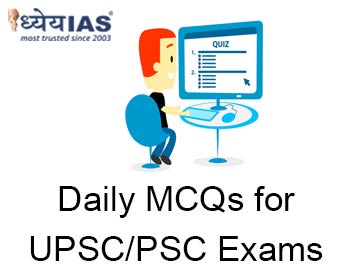Home > Daily-mcqs
Daily-mcqs 01 Oct 2025

Q1:
Which of the following statements about overall crime in India in 2023 (as per NCRB) are correct? 1. Total cognizable IPC + Special & Local Laws (SLL) crimes increased by about 7.2% over 2022. 2. Murder cases increased in 2023 compared to 2022. 3. Crime rate per lakh population rose from ~422.2 in 2022 to ~448.3 in 2023. Select the correct options:
A: 1 and 2 only
B: 1 and 3 only
C: 2 and 3 only
D: 1, 2, and 3
Answer: B
Explanation:
· Statement 1 is correct. In 2023, there were ~62,41,569 cognizable crimes, which is about a 7.2% increase over ~58,24,946 in 2022.
· Statement 2 is incorrect. Murder cases actually declined by about 2.8%, from 28,522 in 2022 to 27,721 in 2023.
· Statement 3 is correct. The crime rate per lakh population rose from ~422.2 in 2022 to ~448.3 in 2023.
Q2:
Which of the following activities require prior approval of the National Biodiversity Authority under the Biological Diversity Act, 2002? 1. Any person (foreign / non‑Indian) accessing biological resources from India. 2. Transfer of research results (derived from biological resources) to non‑Indian entities. 3. Applying for an Intellectual Property Right (IPR) outside India based on biological resources obtained from India. 4. Domestic citizens using biological resources for traditional agricultural farming. Select the correct options:
A: 1 and 2 only
B: 1,3 and 4 only
C: 1, 2 and 3 only
D: 1, 2, 3 and 4
Answer: C
Explanation:
· Sections 3, 4 and 6 require prior approval of the NBA for foreign access, transfer of results to foreigners, and for applying for IPR based on biological resources from India.
· Domestic traditional agricultural uses, or traditional practices (like farming, beekeeping, livestock rearing) are generally exempt under the Act when they do not amount to commercial bio‑survey / bio‑utilisation.
Q3:
Which of the following bodies are statutory under the Biological Diversity Act, 2002? 1. National Biodiversity Authority (NBA) 2. State Biodiversity Boards (SBBs) 3. Biodiversity Management Committees (BMCs) Options:
A: 1 only
B: 2 only
C: 2 and 3 only
D: 1, 2, and 3
Answer: D
Explanation:
All three bodies, NBA (central level), SBBs (state level), and BMCs (local level) are statutory bodies under the Act.
Local bodies (municipalities / panchayats) are required to constitute BMCs; they are local self‑government institutions and prepare People’s Biodiversity Registers.
Q4:
Which of the following are correct about the theme and purpose of the 2nd Global Conference on Sustainable Livestock Transformation by FAO? 1. The theme was “Fostering Change, Scaling Innovations, Driving Solutions.” 2. FAO’s LEAP Partnership launched two technical guidelines during the conference about ecosystem services and the circular bioeconomy in livestock systems 3. FAO announced a goal to cut global livestock greenhouse gas emissions by 50% by 2035. Select the correct options:
A: 1 and 2 only
B: 1 and 3 only
C: 2 and 3 only
D: 1, 2, and 3
Answer: A
Explanation:
Q5:
Which of the following statements about the new siphon‑based thermal desalination system (IISc) are correct? 1. It uses a composite siphon comprising a fabric wick and a metallic grooved evaporator to minimize salt accumulation. 2. The air‑gap between evaporator and condenser is around 5 mm. 3. Under 1 sun illumination (≈1000 W/m²) with ~3.5 wt% saline water, its water collection rate is over 6 L per square metre per hour. Select the correct option:
A: 1 only
B: 1 and 3 only
C: 2 and 3 only
D: 1, 2, and 3
Answer: B
Explanation:
· Statement 1 is correct. The system uses a composite siphon (a fabric layer + grooved metallic substrate) in which the fabric delivers the water by capillary, and the metal grooves help spread it and reduce salt buildup.
· Statement 2 is incorrect. The air‑gap between evaporator and condenser in this system is 2 mm, not 5 mm. A low air gap helps higher condensation efficiency.
· Statement 3 is correct. The system achieves about 6.23 L/m²/hr under ~1000 W/m² illumination and ~3.5 wt% salinity water.